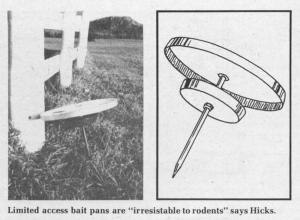1983 - Volume #7, Issue #1, Page #14
[ Sample Stories From This Issue | List of All Stories In This Issue | Print this story
| Read this issue]
New Bait Stations Wipe Out Gophers
 |
His answer?
Gopher "bait stations". The lethal bait stations are, frying pan-shaped covered feeders anchored solidly to the ground. Designed to attract only the rodents you're trying to eliminate, they prevent danger to harmless birds and wildlife. Bait is protected from the elements and keeps fresh indefinitely.
"Last year I put five on a 19 acre alfalfa field and got a hefty yield increase and, at the same time, eliminated expensive damage to machinery," Hicks, of Geraldine, Mont. told FARM SHOW. "The fact that these 'bait stations' are protected yet provide unhindered access seems to be irresistible to gophers and other rodents. They die like flies."
Hicks says wildlife officials who have seen his invention are excited because it provides a way to use deadly poisons on gophers and other pesky rodents without endangering wildlife. Many farmers, faced with severe gopher infestations simply scatter strychnine oats, or other poisons, openly on the ground.
Hick's bait stations consist of a 14-in. metal stake threaded on one end, a 5-in. dia. bait pan 1 3/8-in. deep, and an inverted pan 14-in. in dia. and 1 in. deep on top. After selecting a bait site, the stake is driven 10 in. into the ground and the bait pan, with its 2/3 cup of poison, slipped over the top of the spike. It threads down until it catches at ground level. Then, the cover screws on over the bait pan, and screws down until it contacts a spacer above the bait pan.
"They're stamped out from heavy 14-ga. metal ù strong enough to withstand attempts by deer, cows and other animals to gain entry. We have even installed them around chickens with absolutely no problem. Hogs are about the only animals that should not be exposed to the units," says Hicks.
The best time of the year to kill gophers is early in the spring before the grass begins to green, says Hicks. The gophers will often die near the bait stations but, according to Hicks, that doesn't seem to discourage other gophers. "In fact, it seems to encourage them. Each bait station eliminates gophers in about a 100 yard radius. Stations should be placed at the rate of 5 per quarter mile of field edge to keep gophers out of an undamaged field, and near the center of fields with severe infestations.
The stations can be easily moved around as the gophers move, killing or driving them from the farm.
"With 50 stations, I've eliminated gophers on my 1,400 acre farm. However, 5 to 10 stations will clear up most severe problems in individual fields. The investment is easily paid for in restored yields and decreased damage to equipment," says Hicks.
Except for drifting snow, pans are completely protected against the weather. They can be placed around farm buildings, or in yards, for rats and mice, although Hicks cautions that they should not be placed where small children can get into them.
Hicks also cautions that, although he's sold more than 700 bait stations to local and state farmers, "they have not been tested thoroughly on rats, or on other gopher varieties in other parts of the country. It is not clear,how eating habits vary among the different types of gophers."
Hicks notes that the kill will only be as good as the rodenticide used. "Bait stations are so new, we're still in the process of determining where they will work and where they won't," he points out.
Bait stations come in several models, all with different spacings for different size rodents. They're available for gophers, mice, rats and prairie dogs, and sell for $15 each, fob. He's looking for dealers and distributors to handle the units.
For more information, contact: FARM SHOW Followup, Eco-Bait, Donald D. Hicks, Geraldine, Montana 59446 (ph 406 737-4291).

Click here to download page story appeared in.

Click here to read entire issue
To read the rest of this story, download this issue below or click here to register with your account number.




